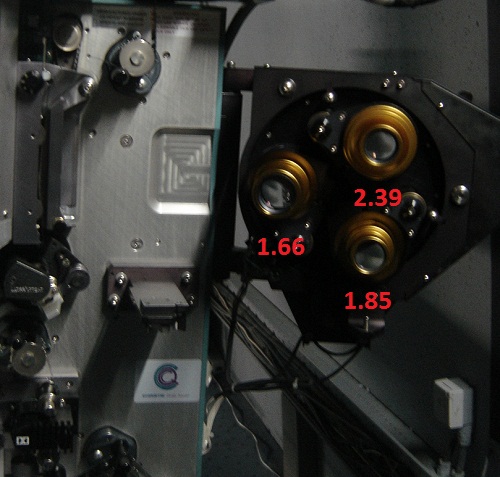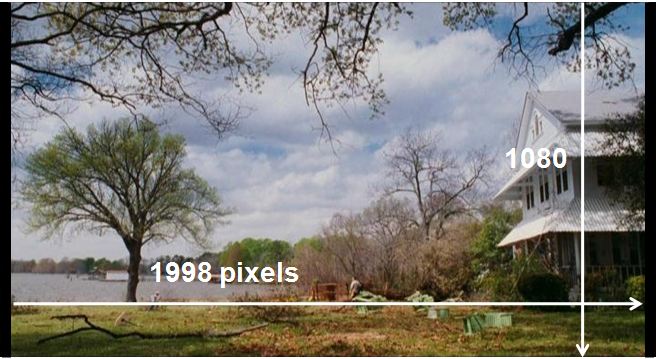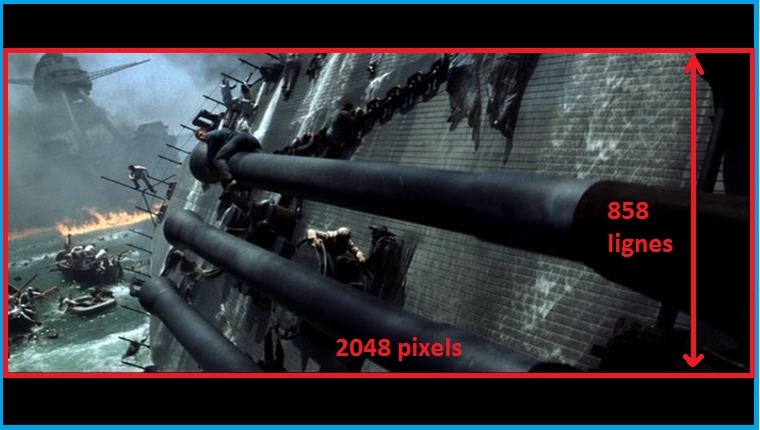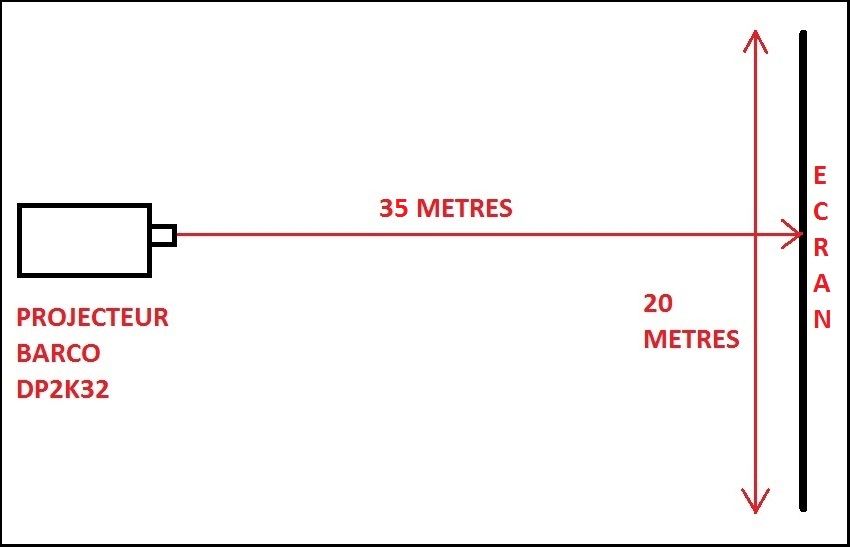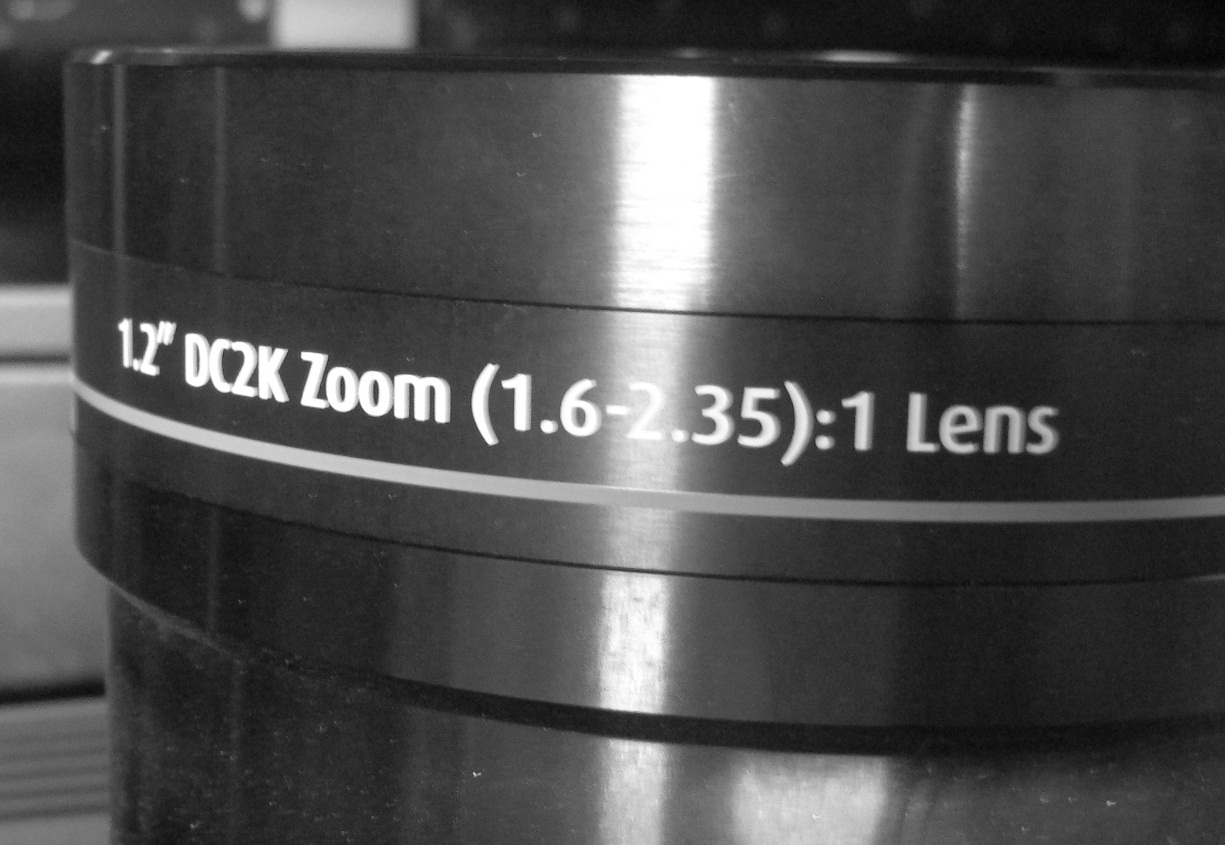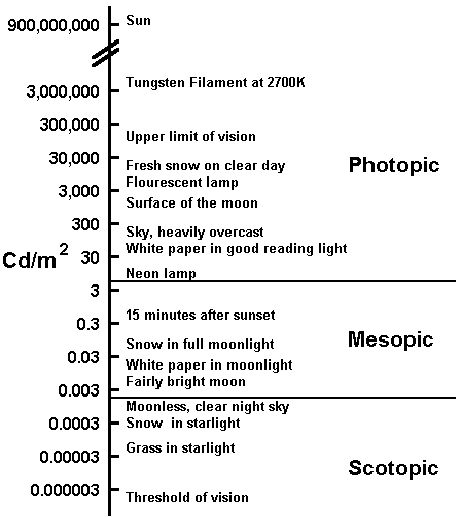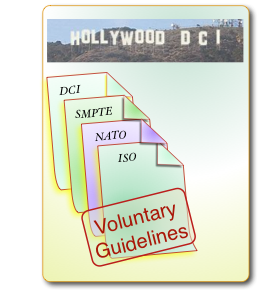
The second issue has to do with enforcement of SMPTE/ISO/DCI standards. This author made a presentation to this point in 2008 at the EDCF/IBC final day presentations, illustrating that all three groups (and NATO) created voluntary standards. This author even made the compulsory presentation joke, paraphrasing Stalin concerning the Pope – that none of these groups have any tanks, or even a police department. (Nobody laughed then either.)[See: Training and Compliance]
We then pointed out that any company that signed a VPF deal with a Hollywood studio typically has a clause that mandates that they will follow all SMPTE/ISO and DCI specifications and recommended practices. This puts the studios in the position of being the police. Certainly if a cinema facility were to violate a part of a security specification, there would be no movie sent to that offending machine or perhaps, that party…(even if it were 3D, which doesn’t have any security specs mentioned?) Why would a quality issue be any different than a security issue? [ Cinema owners understand this issue: at every consequential point they ask – as one did during a recent SMPTE HFR webcast, “Will my equipment need another round of DCI Certification if I modify it for HFR?” The presenter danced around the correct answer.]
The reason might be that d-cinema performance issues have always evolved. DCI studios have generally enforced their rules only when one manufacturer can show that there is a way to make equipment, or a workflow, which can be made generally available and which follows the rules. Enforcement of key security, MPEG to JPEG, and other “standards” were migrated to in this fashion, so much so that there is an interim “InterOp” “Standard” that is being migrated from this year. SMPTE Specs and Recommended Practices can be migrated to because, now, finally, the SMPTE Standards and Recommended Practices have all been voted on and stamped and moved to ISO for Internationalization of the standards…and manufacturers make equipment and workflows which have all been laboriously tested and shown to work (thanks ISDCF~!).

Allowing 3D movies to be presented at less than 48 candelas/m2 is one more example of studio leniency while the industry works out a technical solution. If RealD were able to productize the Argonne National Laboratory method of Acoustic levitation (- YouTube) to place a screen full of polarizing particles that reflected an evenly spread 48 cd/m2 throughout an auditorium without the arbitrary vagaries of silver screens and the predictable vagaries of high-gain screens, one could bet that there would be a date certain cut off of material to those who didn’t have equipment that complies. (Full disclosure: We know nothing about the scope of RealD’s Acoustic Levitation research deep in the mountains behind their Denver labs.)
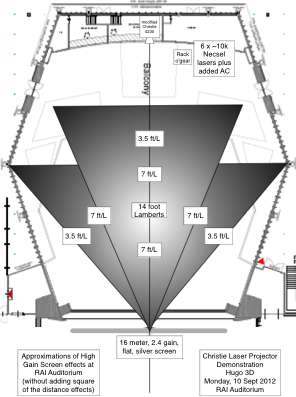 Finally, just so we can get to the main attraction, we’ll skip further details about silver and high-gain screens. We sat in the center of the house, immediately behind where the room is calibrated from. Pictures and comments about general screen effects can be read about in the earlier article:
Finally, just so we can get to the main attraction, we’ll skip further details about silver and high-gain screens. We sat in the center of the house, immediately behind where the room is calibrated from. Pictures and comments about general screen effects can be read about in the earlier article:
Lasers, Christie, IBC…Silver Screen Why [Update 2]
and also see CineTech Geek’s video of: Demonstration of Silver Screen compromise]
There are screen effects specific to lasers, and there were dozens (hundreds?) of people looking for them. Speckle is the most famous, but perhaps the most around-the-corner insidious is metamerism. Both problems are see-able in certain circumstances with Xenon bulb powered projectors. Fortunately or unfortunately, watching a movie like Hugo after a long day of conventioning doesn’t put ones eyes in the best condition for analysing…but that won’t stop the digital illuminati.
First off, Hugo is just too easy to slip into pure suspension of disbelief. Absolutely gorgeously and inventively shot. Many cool things to watch. Hugo stereographer Demetri Portelli showed some comparison clips at 2 different light levels…everyone should see those clips. Anyone who doesn’t see that much light in their local theater should be asking for a discount instead of an upcharge. Just before the complete film ran, Demetri said he was pleased that the movie at its proper level was “finally seeing the light of day.” — immediately, your author realized he couldn’t recall if there were any daytime shots in the movie.
To that point, long-time digital cinema tech exec Patrick von Sychowski said, it was “almost as if the railway scene had been shot two hours later in the morning.”
What wasn’t there to watch for was any bright clear skys with fields of green grass and trees moving in the wind. In fact, there were no patches of green to be seen. If we had been watching Toy Story or The Incredibles, this would probably have been a medical event, or so some experts have said. As it was, it was a great way to demonstrate a movie with lasers for its projector’s primary source for the first time.
Peter Wilson, Principle at HDDC – famously insightful on testing and objective technical analysis – sent a quite positive, and somewhat complete list of points. The line numbers have been added to make commenting simple:
1) I went and it was awesome, like a different movie. Very engaging – people were laughing at Sacha Baron Cohen as you could actually see the detail of his performance.
2) Rating 10/10 for the public 8/10 for experts.
3) Issues were some temporal axis distortion but the movie was shot by professionals to minimise 24 fps artefacts.
4) Speckle, mostly invisible but in one scene with a flat red field near the end it was very visible. Public would probably think it was an effect.
5) Really noisy fans.
6) Silver screen used to make the 14 ft lambert claim but I cannot comment about this as I was sitting in just about the best place.
7) Allegedly they vibrated the screen to minimise Speckle.
8) Good work in progress but Christie guy said don’t hold your breath for availability and the technology may never be cheaper than Xenon.
9) The demo showed it’s possible to use laser illumination, maybe 3-5 years before it could be a main stream business.
10) So I made sure I sat in what I thought was the best place… A good effort I think but I cannot comment on other seating areas.
11) In reality It was good enough to concentrate on the story not the technology.
Number 11 really is the kicker. When we were sitting waiting for the show to get under way the fan noise was gruesome. Once the movie started, I forgot to notice. Compared to the miserably dark, sparkly-at-the-edges-of-objects movie that I had seen with the cheap passive glasses in the past…well, there can be no comparison.
Number 7 – There were devices mounted on the back of the screen. Whether or not they were on and used cannot be verified at this time, but they were seen and documented. They were mounted in 3 rows across the screen (4 pipes tied together to make one long one), somewhat in this fashion:
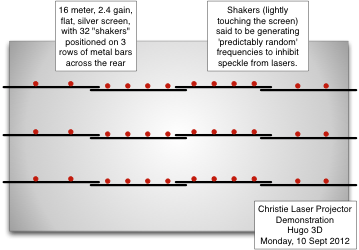 What is known is that silver screens should be worse for laser projection. But the choices that Christie had at IBC were 2 screens; one flat white screen, said to have a 1.4 gain (which Dolby showed Promethus on two nights before), and a 2.4 gain silver screen.
What is known is that silver screens should be worse for laser projection. But the choices that Christie had at IBC were 2 screens; one flat white screen, said to have a 1.4 gain (which Dolby showed Promethus on two nights before), and a 2.4 gain silver screen.
For all that they had 6 x 10k+ lumen Necsel laser units feeding into the projector, they didn’t have that much coming out. General guesses are that they had about a third that at the lens…which is really quite good for this un–productized system.
The hype machine had pressed forward the idea that they were going to show 14 foot Lamberts, so they didn’t have a lot of leeway. There were rumors of late nights pushing to get 12 ft-L. In the end, without being there at the time of the final tweak, there was no way to know except to trust. (Details about current expensive test tools not being able to work accurately with laser light presentations is yet another white paper to write.)
The reality was that in the center of the room it seemed a little over-bright, but that could have been because the movie wasn’t mastered for that brightness, but for something more like the average of the room. (While the hype machine would get very specific about some things, they left the “Was Hugo re-mastered (color timed) for 48 candela/m2 (14 ft./lamberts)?” question with a “…yes, this version was specially colour-timed for higher brightness projection.” which left the answer to the question open to interpretation.)
Nonetheless, early thoughts that the silver screen was used because combining the randomness of shakers with the unpredictable silver surface may be clever or may be bollocks. Perhaps the silver was choosen because it was the choice that they had for “high enough gain” to get to 14. Details about shakers seem known in the community, so we’ll have to dig into a special article for that later as well. It is said that this will be the only way to get Necsel devices to work, for a number of reasons. Another projector manufacturer is said to be trying this for their IMAX development.
Necsel was one of the celebrity hot California companies for a while, hoping that rear-view laser projection would catch on at the home. They went through hundreds of millions of dollars and didn’t come up with a commercially viable product. They did provide enough of a product to allow Kodak to make a laser projector demo, which many people at the time thought was a pure stock play, a tool to help them appear to still be alive. Necsel weren’t bought outright by Ushio, Christie’s parent company, but Ushio did buy 51% of them.
Despite all that work, there was speckle, and the big RED patch that appeared for a few second wasn’t the only hit. The scrolling titles at the end exhibited it as well. As the Christie spokesman of the evening pointed out, there are several manufacturers going several different ways right now. Most are fighting the wrong technology because they think it might be easier in the end (“Why go for a high tech solution when a low tech one will work,” is what one engineer quip’d.)
What this says is that there is a need for an objective metrology to give everyone a language to speak with and a guide to what is acceptable and what isn’t. While watching the latest ASC camera test results on the same afternoon, it also occurred to us slow ones in the room that a piece of StEM-like content – specifically designed for laser projection – would be excellent.
In fact, there were two technical groups in the laser field working on “big topics”. The first is well known as LIPA, Laser Illuminated Projector Association, and is active. This group is attempting to show that laser illuminated projectors can be certified safe on the federal level rather than requiring each system to get a permit from local, state and federal groups. Good effort, but not improving the science.
It seems that there is no bandwidth for the group that is required to create the metrology and help the science of identifying and quantizing speckle and metamerism. There was a proposal document for measuring speckle distributed at the SID conference 2 and a half years ago, but nothing seems to have happened since. At a Hollywood SMPTE meeting we learned that Laser Light Engines had reduced Speckle Contrast Ratio to below 1% (not to 1% of that of a fully coherent laser.) It would be great to learn about what measurements besides the marquee “14 foot Lamberts” that the PR people flaunted so well.
To be continued…because we must..have to…challenge the metamerism discussion…which is difficult since the usual web-search suspects all spin too many complications into the discussion. Perhaps a color and eye scientist can get something out of the far too complicated Wikipedia article, but like so many articles, if you know the subject already you can find the errors but don’t have time to fix them.
The other reason that searching the web doesn’t work for this topic is that most approach it from too general of a direction. The majority of articles speak to buying a carpet that you think is grey in the store and it is a shade of brown in the office…or vice-versa or a dress or something from your printer. Then they’ll point to the bandwidth of the light being more or less yellow in one place or the other. Which is fine, as far as they go.
But the difference in this discussion is not only in the difference in how people see but the difference in the way projectors manipulate light before it hits the chip and the famous entendue.
When we think of color science we think of the CIE, and spectral sensitivity curves, and 2 or 10 degree horseshoes. What we don’t think of is that the 1931 curves were derived from tests of less than 20 people and the 1964 derivations came from a few dozen Londoners (including perhaps 2 foreign students.) Yet our act of seeing involves millions of cones that are sensitive to varied colors and many more millions of rods and a matrix of purposeful cells in front of and behind them all (including for some bizarre reason, our eye’s blood vessels.) There are chemical reactions that these fire off, which can affect small changes or large (who hasn’t felt the bleaching effect that protects the mechanism when we foolishly look at a super-bright light?) And then these bundles of nerves get sent to many different fast and slow processing sectors of the brain.
End result: We all see differently. Generally, this isn’t a problem. We usually are tasked with processing fairly wide bands of wavelengths of light. The two CIE horseshoes derived from 50 people does a fairly good job of typifying billions of us.
Cutting a long story short though, lasers are nano-small. Like other sciences at those small sizes, things be different. A patch of color illuminated by a laser can look bright green to me while perhaps bright yellow to you. (If I understand it right, the differences follow along the line from the primary through the white point to the secondary. So: blue to yellow, green to magenta, red to cyan. That this provokes a complete discussion – in a separate article – of the opponent theory of color…)
Matt Cowen spoke briefly to this issue while d-cinema was still in primordial soup. Others have mentioned it since then, but it wasn’t an issue to study. Now it can be seen and any group putting up a picture with tightly focused laser colors (anyone but Laser Light Engines at this point, which broadens the laser light away from just one frequency) will run into this issue.
Did we see it last night with Hugo? I spoke to people who thought that they saw it. When I said, “The blue in Sasha-Cohen’s uniform?” they said, “Exactly~!” But there is no way to tell. That could have been a directors choice and we were seeing the exact proper color.
Or, we may have been seated in the bright seats with a movie color timed (mastered) at 8. All we know from the Chistie hype-machine is “specially colour-timed for higher brightness projection”. How to make that decision? Statistically there were maybe only 10 seats in the room that received as much light as the radiospectrometer that set up the room in advance of the screening. The fall off of light from a 2.4 gain screen is pretty steep. It would take a good algorithm to figure the deviation down to scotopic light levels. But looking at the width of the room one would guess that more saw it at 6 or 8 and below than at 10 and above. If it was mastered for 8 and we in the center of the room saw it at 14, that’s a prety big disparity and would make the blue of the uniform somewhat washed out and looking ‘different’.
Ultimately, we saw a science experiement without the benefit of knowing the science. Perhaps we will in the future. Certainly there isn’t any secret sauce here. If it is true that Barco is also trying to use shaking devices to reduce speckle, they already know what Christie knows. They are probably wondering what went wrong to make that big field of red go glisten just like everyone is.
What we heard – Several people comment about the high level of the fans and electronics which most presume is the cooling system for the rather impressive tower housing the laser system. We understand that that section alone was fed with 60 amps, 3 phase. But I swear that if tortured I would say that I never heard them once I got into the movie.
What we saw –
The Hype – There were several companies in competition for the Buzzword Compliance Award 2012 at IBC this year. The wording of the press releases for this event was typical of the Christie and Barco tit-for-tat hyperbole festival whenever thay world-first something.
The Reality – What level of lumens were coming out of the lens? hitting the screen? getting to the glasses? though the glasses?
– There was a reason that Necsel spent 200 million and sold for dimes…long story perhaps best left for later.
– Shaking – Want. More. Data.
Different Reactions – More to come
Different Science – There is some fear that by the time lasers are ready to play that 1) everyone in the cinema world will have bought their projector-for-life and all we will get is laser-retrofits and/or a new screen of OLEDs will be presented at huge contrast/huge light/huge size/ small price. Laser retrofits don’t have the best features of lasers. Get rid of all of the light pipes and prism and reflector this and that and toss the light straight on the chip and out of an F6 lens for ultimate of inexpensive and green. Christie’s comment at the beginning of the show reminds some of the statements from IBM in the mid-80’s about computers that would hold the market in suspence while they got their act together. Some say that lasers will invade the field in one or two years, though people said that one or two years ago. As far as an emmisive technology, I think we need a buzzword for self-growing crystals that suspend themselves in the screen position, adapting to holo-metadata (and blocking the EXIT lights until needed.)
Future – Regardless of every torture or flaw, Christie stuck their necks out and performed excellently. The perfect picture, great technology that didn’t really hiccup once going. They provoked discussion that the industry will have to come to grips with while it is distracted with high frame rates. And they moved the bar up. Until someone can show a productizable, no speckle system, no one will be able hit Hyperbole: Plaid :11 anymore, which is a good thing.
Lonks:
Minimizing Observer Metamerism in Display Systems Rajeev Ramanath, 7 March 2008

 Certainly, the Harkness seminar will go through this. Perhaps they’ll even describe how to actually tweak a room for 3D because this seems to be a mystery for even the most experienced of technicians, or how the hot spots and splotchiness of silver screens don’t violate SMPTE and DCI specifications.
Certainly, the Harkness seminar will go through this. Perhaps they’ll even describe how to actually tweak a room for 3D because this seems to be a mystery for even the most experienced of technicians, or how the hot spots and splotchiness of silver screens don’t violate SMPTE and DCI specifications.